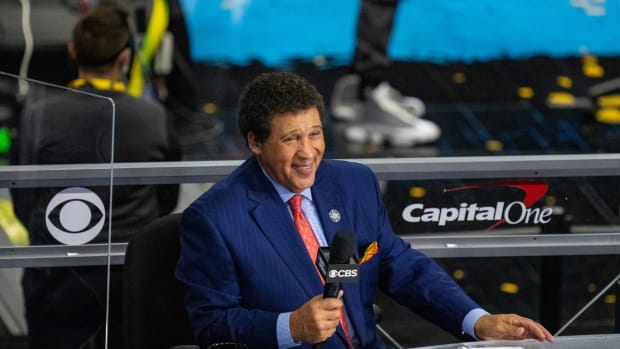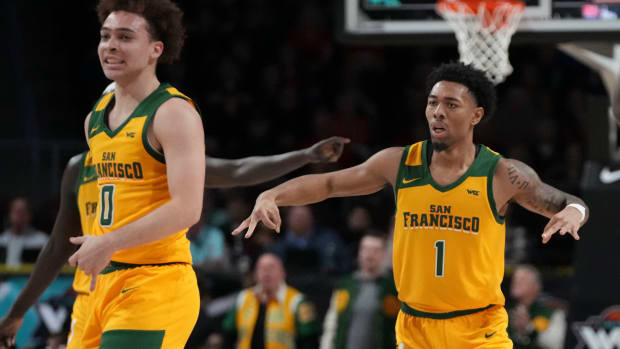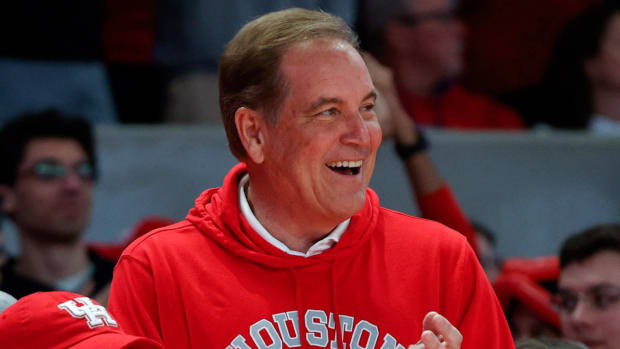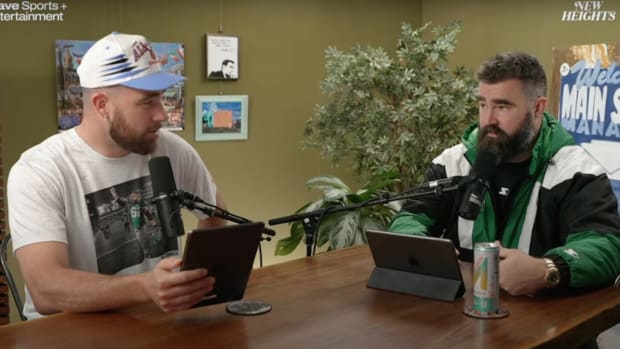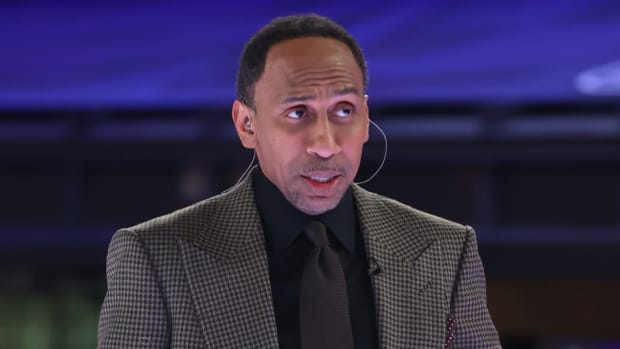Which WWE Storylines Would Make the Best ESPN 30 for 30's?
By all the measures used when evaluating television shows, from viewership data to social media buzz to critical acclaim, the ESPN Films presentation of “Nature Boy” on Nov. 7 was a success. The documentary on the life and times of pro wrestler Ric Flair averaged 1.8 million viewers—the most-watched 30 for 30 doc since Dec. 10, 2016 (Catholics vs. Convicts, which had 2.1 million viewers and aired after the Heisman Trophy ceremony). It was the highest rated original show on cable that night for adults 18-49 and ESPN said the film produced 238,000 Twitter interactions on the night of the doc’s debut.
The success of the Flair film should prompt a question for ESPN Films executives (and other high-end sports documentary film house): Will we see more pro wrestling stories get the high-end documentary treatment? For me, this is a no-brainer: They absolutely should, especially given the compelling material out there. Yes, the Flair doc had some built-in advantages given the immense promotion the subject did for the film, as well as promotional and production support (e.g. archival footage and making talent available for interviews) from the WWE. ESPN also smartly aired the documentary at 10:00 p.m. ET on Nov. 7—the latest-ever start for a 30 for 30—in order to get some of the audience from WWE SmackDown, which airs from 8 to 10 p.m. ET on USA Network.
ESPN's Ric Flair 30 for 30 'Nature Boy' Gives Revealing Look into Wrestler's Private Life
Libby Geist, the vice president and executive producer for ESPN Films and 30 for 30, said in an interview with Sports Illustrated this week that the viewership for Flair exceeded the expectations of her division. “Given the buzz around the story, the amount of internal marketing we got, and the insanity of WWE fans, it did lead us to believe we might have a big night,” she said. “But when we released the trailer last month and saw how well it did socially and on our digital networks, we realized we had underestimated the fandom of Ric and this story. Once we saw the trailer take off so well, we thought “This might be bigger than we thought.
“I certainly think with the success of the Ric Flair documentary, we are definitely looking into other [wrestling] stories,” Geist continued. “We don’t have any in production right now but we are really enthused about working with WWE and their athletes. But you have to be careful. It can’t just be, 'We have to do WWE again.' It has to be who is the right storyteller, the right subject and is this the right time to do it.”
On that note, I decided to put together my own list of wrestling subjects who would make for compelling 30 for 30's. I also compiled the opinions of longtime professional wrestling journalist Dave Meltzer, the editor of the Wrestling Observer Newsletter and WrestlingObserver.com and a writer for MMAFighting.com, and Conrad Thompson, who co-hosts two of the most popular wrestling podcasts in the audio space: Something to Wrestle (with Bruce Prichard) and What Happened When (with Tony Schiavone). Hope you enjoy:
DEITSCH
Roddy Piper: The greatest heel in the history of the genre and one of the most charismatic figures in sports entertainment history. Piper’s backstory (he was born in Saskatoon, Canada and worked the Pacific Northwest territories as a young performer) has plenty of grist and he was in the middle of the WWE’s morphing into popular culture in the 1980s (thanks, MTV), which helped produce wrestling’s explosion. He had a successful foray in Hollywood and his later years with the WCW during the Monday Night Wars adds another element to a can’t miss doc.
Randy Savage: The Macho Man was one of the great in-ring performers but what makes his story compelling is what is always interesting about professional wrestlers and particularly the stars of the 1980s and 1990s—where does distinction lies (if any) between the in-ring character and the real man? Savage’s father (Angelo Poffo), brother (Lanny Poffo) and ex-wife (Elizabeth Hulette) were also in the business and his tragic death at 58 (he suffered a heart attack while driving with his wife) adds another layer of storyline.
The Hart Family: The greatest family in the history of professional wrestling, led by patriarch and wrestling legend Stu Hart. The family experienced massive highs (Bret Hart’s remarkable career and the success of the British Bulldogs) and the lowest of lows (Owen Hart’s death in 1999).
More Significant Layoffs Are Coming to ESPN
Andre The Giant: Andre’s story has always been the Holy Grail for documentarians. HBO announced last February it had commissioned a film on the legendary professional wrestler, which will be co-produced by HBO Sports, the WWE and the Bill Simmons Media Group.
Gorgeous George: The greatest self-promoter of his era and the forerunner of all the great promo artists you see today. The tricky part here would be to make it commercial, given George (real name: George Raymond Wagner) died in 1963.
Vince McMahon: As both Meltzer and Thompson write below, an honest documentary on Vince would be incredible television but it seems unlikely to happen during Vince’s life.
Chris Benoit and Eddie Guerrero: The names might not be known to 20-something sports fans but Benoit was an immensely talented performer who the WWE has intentionally distanced itself from given the circumstances of his death. Benoit killed his wife and 7-year-old son in their house in Fayetteville, Ga. in 2007, before taking his own life by hanging himself with a cable from a weight machine in his home gym. This is not a doc where you would get WWE support given Benoit’s abuse of steroids but it is an immensely important story of the era. I would also put Guerrero here as another compelling figure for documentarians. His family had a storied history in the world of professional wrestling, dating back to the 1930s. He was found dead at age 38 in a Minneapolis hotel room in 2005.
Hulk Hogan: An obvious suggestion given his importance in the business. Thompson spells out the reasons below.
The nWo: Obviously, we've seen this group covered in many places already—including docs on the WWE network—but the angle of Scott Hall and Kevin Nash invading WCW (followed by Hogan as the third man) never fails to be entertaining television.
CM Punk: One of the most popular WWE stars of the 2010s, Punk (Phil Brooks) abruptly left the WWE in 2014 due to irreconcilable differences with the company. Punk’s anti-establishment persona, his rise from regional promotions and his fractured relationship with the WWE power brokers would make for a compelling exploration.
Ranking the Best 30 for 30 Documentaries (So Far)
DAVE MELTZER
There are so many: Bruiser Brody would be my first pick, just because of the story of his death. Bruno Sammartino would be right there, more because of his childhood and his unique connection with fans of an era. Those are the two that you'd want a feature film done on. Superstar Billy Graham.
Dusty Rhodes. Andre the Giant would be good but HBO is doing that one right now as a special. Flair's allowing himself to be an open book and his unique personality carried it the way few others could. There is nobody with the depth of character like Flair in the sense that you could have done five on him and still had stories and directions still left to explore.
The Von Erichs had a mini one done a few years ago and I really didn't think it was that good, but it's still a fascinating story. Maybe Chris Benoit although that becomes a very touchy subject and very few knew him well. Brian Pillman would actually be great. It would never play or do ratings in the U.S. but the most important pro wrestling figure in history was Rikidozan, but nobody here knows him but he's still the national hero in North Korea and for older people in Japan is also a national hero. The dichotomy of how schoolchildren in North Korea are taught about him and the reality is a fascinating story. Hulk Hogan and Dwayne Johnson (The Rock) are always there as far as being famous but Johnson is too soon, Hogan certainly has had life twists and turns but I don't know that you'd ever get any real depth out of that story. Paul Heyman would be another one, a complex, brilliant, charming and often deceptive character. A real in-depth piece of Vince McMahon would be fascinating but too many people would be afraid to talk even now in public so anything you'd get would be pretty shallow.
The Making of Tony Romo, CBS NFL Analyst
CONRAD THOMPSON
The Rock is the most obvious choice. His grandfather was a wrestler and his grandmother was a promoter in Hawaii. They never wanted their daughter to date a wrestler so of course she married one. But he was a wrestler during the territory era of the business and was coming up when race relations weren’t exactly ideal for a black man in America. So the Rock grew up a young man who knew a little about the highs of the business but probably became an expert in the lows. Yet somehow when football didn’t work out, he found himself in the family business. Obviously, he excelled more than anyone could have ever imagined and has become the biggest star the industry ever knew.
I think Jerry Lawler’s story reads like a movie. From a kid who grew up a fan drawing cartoons of his idols getting his foot in the door to becoming a top star to owning a territory and setting records in the business to the angle with Andy Kaufman that captivated the mainstream, Lawler knew when to hedge his bets and join the WWF when it was clear Vince McMahon was about to be the only game in town. Lawler owned Memphis the way nobody ever owned a town. They sold out the same building every week selling tickets to the same fans for years. They did Super Bowl level TV ratings every week. All of this was based around a guy who didn’t look like the monsters in the WWF. He had the vision to see what Kaufman could mean for business when McMahon did not. As far as wrestling announcers go, he got the most coveted job in the industry with no experience and then he kept it for over 20 years. It’s really amazing what he’s been able to do and unlike so many in the business, he saved his money. He didn’t drink or do drugs and no one has ever accused him of being a steroid user.
Kurt Angle is a no-brainer. He won a gold medal at the Olympics only to discover that making a living as an amateur wrestler is harder than it looks. Working in local news wasn’t for him so he looked at what he said many times he never would—professional wrestling. The nagging injuries weren’t going to keep him from achieving at the high level he wanted so he turned to drugs and before you know it, he’s addicted. His drinking increased and problems at home became amplified. Rather than accept the help he needed, he denies there is a problem and goes to the minors. Life only gets worse from there. A messy divorce, his boss starts dating his wife, multiple run-ins with the law, more children, more bad relationships, more drinking, more rehab and then somehow a success story. Only someone who won the Olympics with a broken neck could “pull the nose up” after all that. But it’s true, it’s damn true, and now he’s back as a Hall of Famer. A true American story of redemption.
Hulk Hogan is my last very obvious answer. Hogan set the business on fire with Hulkamania and helped take wrestling mainstream with cartoons, action figures, network specials in primetime and the spectacle that is Wrestlemania. But what Hogan doesn’t get enough credit for is pulling the business into new highs. When people talk about the late 1990s explosion they credit the Attitude Era, Stone Cold (Steve Austin), and the nWo. But usually folks crediting the nWo mean Scott Hall and Kevin Nash. Hulk Hogan is what took the nWo from another “cool angle” and turned it into a game changer. Without the nWo, would Vince have ever embraced “Attitude?” Hogan was the biggest babyface of all but he made the best heel of all time. WCW did its biggest business with Hogan as a babyface but then he took it to another level as a heel. He had that Floyd Mayweather dynamic in that he ran his mouth so much you would pay somebody, anybody, to shut him up. And when they did, it made them stars like Sting to Goldberg to Karl Malone to Jay Leno. But then coming back home to the WWF, the steroid trial, lying on Arsenio Hall, the reality show, the public divorce, his daughters musical aspirations, the accident that sent his son to jail, a messy divorce, being relegated to the minors of the business with TNA, the failed startup cable shows, the mess with Bubba the Love Sponge and of course, the Gawker lawsuit, there isn’t a more interesting story of highs and lows than Hulk Hogan.
One day a story on Vince McMahon would be hard to beat, but I don’t think we get the true story in the next 10 years.
THE NOISE REPORT
(SI.com examines some of the week’s most notable sports media stories)
1. As SI reported on Thursday, ESPN will lay off more than 100 staffers after the Thanksgiving holidays. The layoffs, which were described by a person briefed on the plans, will hit positions across ESPN including front-facing talent on the television side, producers, executives and digital and technology staffers. The SportsCenter franchise is expected to be hit hard—including on-air people—given the frequency of the show has lessened considerably on main network ESPN. Here is the story.
1a. Sports Business Daily assistant managing editor Austin Karp and Sporting News media writer Michael McCarthy had some interesting numbers on NFL pregame shows last week. CBS, ESPN and NBC all had shows that were down. Fox was up. The details:
Football Night in America (NBC): 7.359 million viewers through the first nine weeks (down 7.2% from 2016)
Fox NFL Sunday: 4.7 million viewers (up 1% from 2016)
The NFL Today (NBC): 3.3 million viewers (down 5.7% from 2016)
Fox NFL Kickoff (Fox): 1.3 million viewers (up 5% from 2016)
McCarthy reported that ESPN’s Sunday NFL Countdown had averaged 1.138 million viewers through the first nine weeks of the 2017 season, down 14.8% from 1.299 million viewers for the same time period in 2016 and down 25.4% from 1.525 million viewers in 2015.
1b. CBS’s coverage of Auburn’s win over No. 1 Georgia earned the highest overnight rating among all the college football games this weekend—a 4.7 overnight. That was the fifth highest overnight rating for all coverage football games this season.
ABC’s coverage of Miami’s blowout over Notre Dame was next with a 4.5 overnight rating. ESPN said its coverage of Alabama’s win over Mississippi State drew a 3.8 overnight, the highest-rated game on cable this season and the second highest rated SEC vs. SEC game this season across all networks behind CBS’s primetime coverage of Alabama’s win over LSU.
1c. The MLB Network said it had its best-ever postseason viewership, with an average of 90,000 viewers per day. It also had its most-watched day on Oct. 6 (813,000 viewers, thanks to the Indians-Yankees game) and its best-ever viewership week from Oct. 2-8 (an average audience of 209,000 viewers.)
2. I was struck by the decision of New York Times writer John Branch not to name Aaron Hernandez by name in his Nov. 9 piece on the neuropathologist and her associate who examined Hernandez’s brain. Here is what Branch said went into that choice:
“So, you ask, why didn't we use Aaron Hernandez's name in our story? It's sad, but these CTE stories have become familiar, even routine— an athlete (or former athlete) dies, a brain is examined and the results are made public. The New York Times has written dozens of them.
"This felt like a chance to do something different. First, it was Aaron Hernandez, and the story of his life and death has been told again and again, often sensationally; there was little reason to rehash the details now. Second, we already knew that he had a severe case of CTE. That news came out in September, and we wrote about it.
"All that was happening on Nov. 9 was that Dr. Ann McKee, the neuropathologist who has studied more brains with CTE than anyone, was presenting the case to a conference for the first time.
"That got us thinking: Is this even newsworthy? Is there a fresh approach?
"It was Jason Stallman, the sports editor of The New York Times, who wondered aloud last week whether I might write the story without mentioning Hernandez's name. It was an intriguing thought. Not a plan, but a thought.
"Then I spoke to McKee, and quickly realized how little interest she had in the lurid details of Hernandez's background—the arrests, the murder conviction, the suicide in prison. To her, it was just a brain, a magnificent specimen that she believes will help CTE research immensely. She called it "beautiful." That's when I realized it might be possible to disconnect the brain from Hernandez. Let's make it a story strictly about the brain and the science, not the man and his past.
"In the version I filed on Thursday, I waited until the final few paragraphs to mention Hernandez's name. It was either a surprise ending to those who had not yet connected the dots, or it was a confirmation of the brain's identity to readers who knew Hernandez's story all too well. I had a feeling that Stallman might just chop off those final paragraphs. That's what he did. He asked me if that was OK, knowing it was my name at the top. I'm told there was quite a debate in the sports department, and it carried to the highest ranks of the newsroom.
"In the end, we went with it. The online version never identified Hernandez. The only concession was to include a rather obvious, blue-type link in the middle of the text to previous Hernandez stories, in case a confused reader went searching for clues.
"The print version of the story, in Friday's paper, had my original ending, naming both Hernandez and McKee.
"So, your original question: Why? Because we thought it might make a more powerful story, stripped to its essence—no characters, no baggage. After all this time, and all those headlines, it was no longer about Hernandez on the field, but about a brain in a lab.
"Your next question, I'm presuming: Did it work? Sure. Some people were confused or disappointed that we didn't take a straight nuts-and-bolts approach. I'm not sure we would have written that story, anyway. What we tried to do was offer a new perspective on a familiar story, to get people to think of CTE in a different way.”
3. Episode 145 of the Sports Illustrated Media podcast features Geno Auriemma, the head coach for the University of Connecticut women’s basketball team. Auriemma recently debuted a new podcast titled: “Holding Court with Geno Auriemma.”
In this podcast Auriemma discusses why he started a new podcast and why he wanted to host it; what it’s like to ask questions as opposed to answering them; why he opted to have Sue Bird, Kyrie Irving and Tiger Woods as his first three guests; what he took away from his hour-long talk with Woods; how he would classify his interview style; future interviews with John Calipari and Charles Barkley; why he hopes to extend his podcast guests to be people such as Doris Kearns Goodwin; what he decided to go on the “Pardon My Take” podcast and what he thought of that experience; his thoughts on people in sports such as Steve Kerr and Gregg Popovich being very forceful publicly with their politics; why Auriemma has become more politically active on his Twitter feed; given his teams are historically national champion contenders every year, how he would view a potential invite - or non invite -- from President Donald Trump; how often he talks about social issues with his team; whether the loss to Mississippi State relieved a burden for this year’s team, and much more.
Says Auriemma: “What is that people want from us that have a platform? Do you want us to speak out so that you can then say, “stay in your lane.” Do you want us to stay silent? … I’m not representing the University of Connecticut when I voice my opinion. I’m representing GenoAuriemma. That’s it. Someone will say, 'Well, you have a platform so that’s not fair. You should be careful.' Really? You think I have a bigger platform than Rush Limbaugh? He gets to say whatever he feels like. You think I have a bigger platform than CNN, MSNBC, Fox News? No. Does that mean I am not entitled to my opinion?”
You can subscribe to the podcast on Apple Podcasts, Google Play and Stitcher.
4. Non-sports pieces of note:
• Watch Gary Younge’s masterful interview of the loathsome Richard Spencer
• All the respect for actress Ellen Page, who further exposes Brett Ratner
• Via Ross Andersen: What happens if China makes first contact with extraterrestrial intelligence?
• A remarkable wedding vows story by C.J. Chivers of The New York Times
• I was harassed at the New Republic. I spoke up. Nothing happened
• From Chico Harlan of The Washington Post: A small-town doctor wanted to perform surgeries for transgender women. He faced an uphill battle
• Via The New York Times: In the Debate Over North Korea, Does Anyone Care What South Korea Thinks?
• Via Texas Monthly’s Abigail Pesta: A married woman escapes her jihadist husband
• From Maria Popova: Why Haters Hate: Kierkegaard Explains the Psychology of Bullying and Online Trolling in 1847.
• From The Moscow Times: The Soviet Language Revolution
• From Alysia Santo of the Marshall Project: The Unique Sexual Harassment Problem Female Prison Workers Face
• The Ringer’s Bryan Curtis examined entertainment journalists searching for sexual harassment stories in Hollywood
Sports pieces of note:
• NYT’s John Branch on Aaron Hernandez’s brain
• Two good pieces on The Montreal Screwjob from Corey Erdman of Vice Canada and Dan Greene of SI
• From The Athletic: A Minnesotan takes a perilous journey to North Korea in the name of hockey, and friendship
• Lindsey Adler, on a teen girl who posed eight years as a married man to write about baseball and harass women
• The MMQB’s Peter King has some remarkable details about Jerry Jones trying to overthrow Roger Goodell
• From iconic swimmer Diana Nyad: “I'm almost 70. And I’m still not sure I’ll ever fully heal from what my coach did to me”
• SI’s Tim Layden, on sports one year in Trump's America
• Steph Curry, for the Players Tribune, on Veterans Day
• SI’s Tom Verducci wrote a 2010 profile of Roy Halladay. It is worth reading again
5. A look by Canadian blogger Todd T. Hayes on how some Canadian sports outlets covered the death of Roy Halladay
